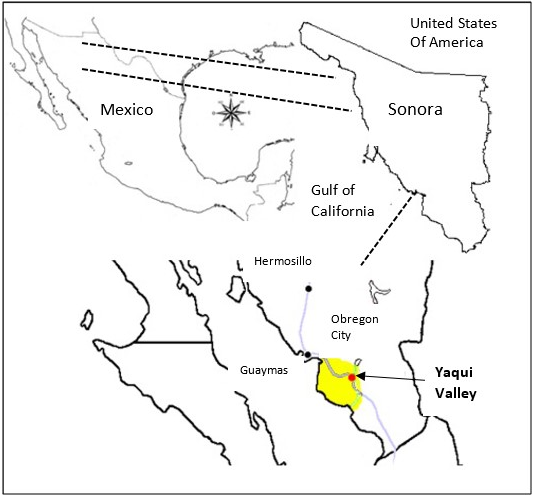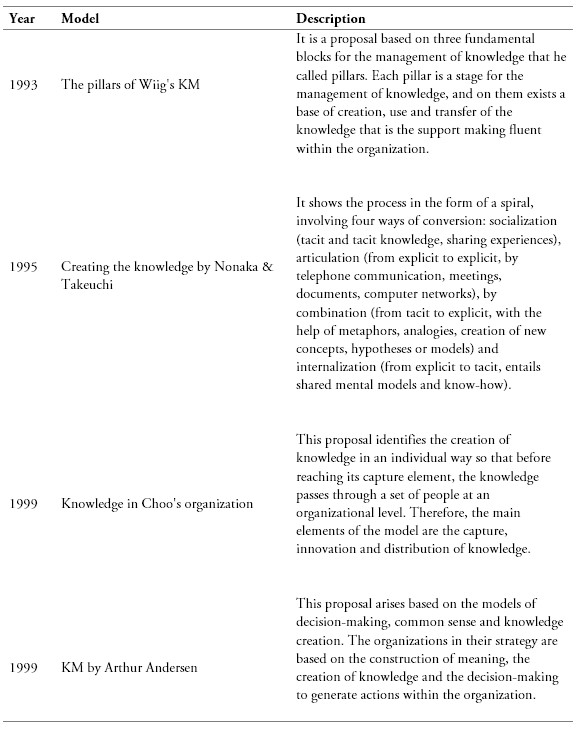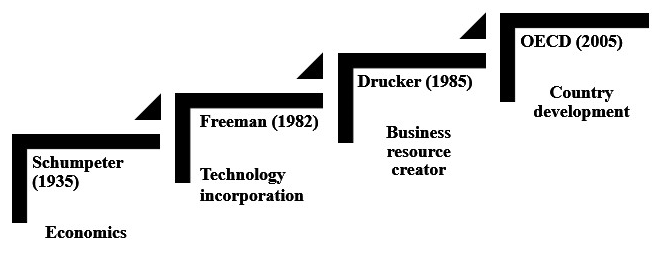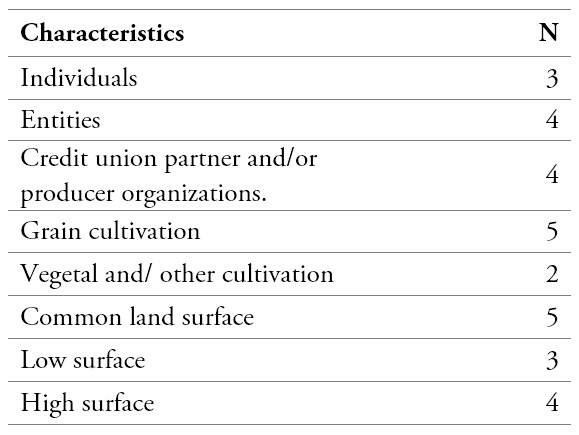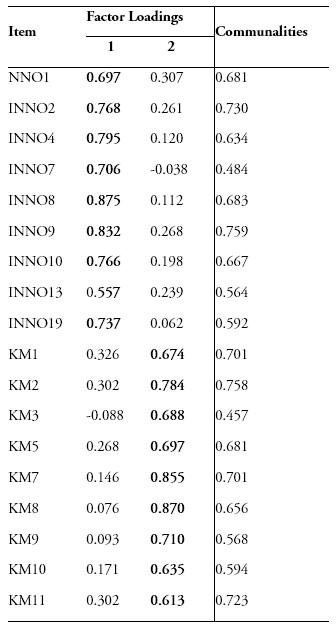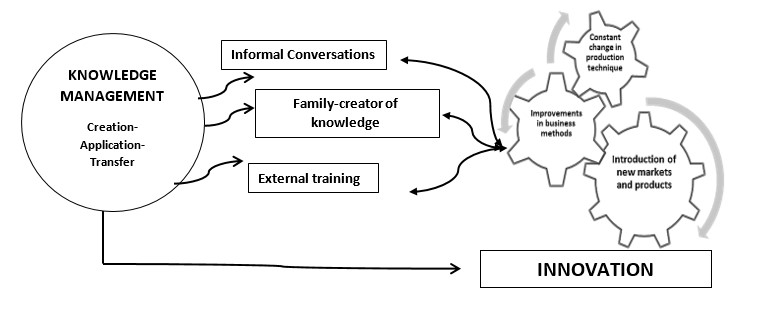Abbas, J., Zhang, Q., Hussain, I., Akram, S., Afaq, A., & Shad, M. A. (2020). Sustainable innovation in small medium enterprises: The impact of knowledge management on organizational innovation through a mediation analysis by using SEM approach. Sustainability, 12(6), 2407. https://doi.org/10.3390/su12062407
Abtew, A., Niassy, S., Affognon, H., Subramanian, S., Kreiter, S., Garzia, G. T., & Martin, T. (2016). Farmers’ knowledge and perception of grain legume pests and their management in the Eastern province of Kenya. Crop Protection, 87, 90-97. https://doi.org/10.1016/j.cropro.2016.04.024
Acosta-Prado, J. C., Navarrete, J. F. F., & Tafur-Mendoza, A. A. (2020). Relationship between conditions of knowledge management and innovation capability in new technology-based firms. International Journal of Innovation Management, 2150005-1. https://doi.org/10.1142/S1363919621500055
Al-Dmour, A., Al-Dmour, R., & Rababeh, N. (2020). The impact of knowledge management practice on digital financial innovation: The role of bank managers. VINE Journal of Information and Knowledge Management Systems, ahead-of-print(ahead-of-print). https://doi.org/10.1108/VJIKMS-01-2020-0006
Allende, T. C., Mendoza, M. E., Pérez-Salicrup, D. R., Villanueva-Díaz, J., & Lara, A. (2016). Climatic responses of Pinus pseudostrobus and Abies religiosa in the monarch butterfly biosphere reserve, central Mexico. Dendrochronologia, 38, 103-116. https://doi.org/10.1016/j.dendro.2016.04.002
Andersen, A. (1999). El Management en el Siglo XXI. Granica.
Andreu, R., & Sieber, S. (1999). La gestión integral del conocimiento y del aprendizaje. Economía Industrial, (326), 63-72. https://www.mincotur.gob.es/Publicaciones/Publicacionesperiodicas/EconomiaIndustrial/RevistaEconomiaIndustrial/326/RAFAEL%20ANDREU.pdf
Badstue, L. B., Bellon, M. R., Berthaud, J., Ramírez, A., Flores, D., & Juárez, X. (2007). The dynamics of farmers’ maize seed supply practices in the Central Valleys of Oaxaca, Mexico. World Development, 35(9), 1579-1593. https://doi.org/10.1016/j.worlddev.2006.05.023
Baloch, M. A., & Thapa, G. B. (2016). The effect of agricultural extension services: date farmers’ case in Balochistan, Pakistan. Journal of the Saudi Society of Agricultural Sciences, 17(3). http://dx.doi.org/10.1016/j.jssas.2016.05.007
Bellon, M. R., & Hellin, J. (2011). Planting hybrids, keeping landraces: agricultural modernization and tradition among small-scale maize farmers in Chiapas, Mexico. World Development, 39(8), 1434-1443. https://doi.org/10.1016/j.worlddev.2010.12.010
Briones-Peñalver, A. J., Bernal-Conesa, J. A., & de Nieves Nieto, C. (2020). Knowledge and innovation management model. its influence on technology transfer and performance in spanish defence industry. International Entrepreneurship and Management Journal, 16(2), 595-615. https://doi.org/10.1007/s11365-019-00577-6
Bueno, E. (1999). La gestión del conocimiento en la nueva economía en gestión del conocimiento y capital intelectual. Experiencias en España. IU Euroforum Escorial, San Lorenzo del Escorial.
Cabeza-Pullés, D., Fernández-Pérez, V., & Roldán-Bravo, M. I. (2019). Internal networking and innovation ambidexterity: The mediating role of knowledge management processes in university research. European Management Journal, S0263-2373(19), 30152-5. https://doi.org/10.1016/j.emj.2019.12.008
Campos, M., Velázquez, A., & McCall, M. (2014). Adaptation strategies to climatic variability: a case study of small-scale farmers in rural Mexico. Land Use Policy, 38, 533-540. https://doi.org/10.1016/j.landusepol.2013.12.017
Cárdenas-García, N. (2016). Movimiento campesino y oportunidades de cambio político y social. La experiencia del Valle del Yaqui (1920-1950). Estudios de historia moderna y contemporánea de México, (52), 69-87. https://doi.org/10.1016/j.ehmcm.2016.06.002
Castillo, Y. B. V., Pritchard, H. W., Frija, A., Veettil, P. C., Sanchez, J. A. C., van Damme, P., & van Huylenbroeck, G. (2014). Production viability and farmers’ willingness to adopt Jatropha curcas L. as a biofuel source in traditional agroecosystems in Totonacapan, Mexico. Agricultural Systems, 125, 42-49. https://doi.org/10.1016/j.agsy.2013.12.003
Chenu, C., Angers, D. A., Barré, P., Derrien, D., Arrouays, D., & Balesdent, J. (2019). Increasing organic stocks in agricultural soils: Knowledge gaps and potential innovations. Soil and Tillage Research, 188, 41-52. https://doi.org/10.1016/j.still.2018.04.011
Choo, C. W. (1999). La organización inteligente: el empleo de la información para dar significado, crear conocimiento y tomar decisiones. Oxford University Press.
Cillo, V., Rialti, R., Bertoldi, B., & Ciampi, F. (2019). Knowledge management and open innovation in agri-food crowdfunding. British Food Journal, 121(2), 242-258. https://doi.org/10.1108/BFJ-07-2018-0472
Cortez-Arriola, J., Rossing, W. A. H., Massiotti, R. D. A., Scholberg, J. M. S., Groot, J. C. J. and Tittonell, P. (2015). Leverages for on-farm innovation from farm typologies? An illustration for family-based dairy farms in north-west Michoacán, Mexico. Agricultural Systems, 135, 66-76. https://doi.org/10.1016/j.agsy.2014.12.005
Djanibekov, N., Djanibekov, U., Sommer, R., & Petrick, M. (2015). Cooperative agricultural production to exploit individual heterogeneity under a delivery target: the case of cotton in Uzbekistan. Agricultural Systems, 141, 1-13. http://dx.doi.org/10.1016/j.agsy.2015.09.002
Dolinska, A., & d’Aquino, P. (2016). Farmers as agents in innovation systems. Empowering farmers for innovation through communities of practice. Agricultural Systems, 142, 122-130. https://doi.org/10.1016/j.agsy.2015.11.009
Dos Santos-Ferreira, V. H., & Santos, A. (2014). The Impact of Knowledge Management in Innovation Performance in the Leiria Region. In European Conference on Intellectual Capital, p. 24. Academic Conferences International Limited.
Drucker, P. F. (1968). The Age of Discontinuity Guidelines to our Changing Society. Harper & Row.
Drucker, P. F. (1985). Innovation and Entrepreneurship: Practice and Principles. Harper & Row.
Dueck, G. (2001). Views of knowledge are human views. IBM Systems Journal, 40(4), 885-888. https://doi.org/10.1147/sj.404.0885
Elmorshidy, A. (2018). The impact of knowledge management systems on innovation: An empirical investigation in kuwait. VINE Journal of Information and Knowledge Management Systems, 48(3), 388-403. https://doi.org/10.1108/VJIKMS-12-2017-0089
Esparcia, J. (2014). Innovation and networks in rural areas. An analysis from European innovative projects. Journal of Rural Studies, 34, 1-14. https://doi.org/10.1016/j.jrurstud.2013.12.004
Ferraris, A., Giachino, C., Ciampi, F., & Couturier, J. (2019). R&D internationalization in medium-sized firms: The moderating role of knowledge management in enhancing innovation performances. Journal of Business Research, in press https://doi.org/10.1016/j.jbusres.2019.11.003
Fidel, P., Cervera, A., & Schlesinger, W. (2016). Customer’s role in knowledge management and in the innovation process: Effects on innovation capacity and marketing results. Knowledge Management Research & Practice: SPECIAL ISSUE: Knowledge Management and Relationships in SMEs, 14(2), 195-203. https://doi.org/10.1057/kmrp.2015.19
Freeman, C. (1982). The economics of industrial innovation. MIT Press.
Fundación Cotec para la Innovación Tecnológica [Cotec]. (2007). La persona protagonista de la innovación. Cotec.
Goktan, A. B. (2005). The Role of Strategy in the Innovation Process: A Stage Approach. University of North Texas Denton.
Hessen, J. (2010). Teoría del conocimiento. Panamericana Editorial.
Ho, K. L. P., Nguyen, C. N., Adhikari, R., Miles, M. P., & Bonney, L. (2019). Leveraging innovation knowledge management to create positional advantage in agricultural value chains. Journal of Innovation & Knowledge, 4(2), 115-123. https://doi.org/10.1016/j.jik.2017.08.001
Hock-Doepgen, M., Clauss, T., Kraus, S., & Cheng, C. (2020). Knowledge management capabilities and organizational risk-taking for business model innovation in SMEs. Journal of Business Research. https://doi.org/10.1016/j.jbusres.2019.12.001
Honorato-Salazar, J. A., & Sadhukhan, J. (2020). Annual biomass variation of agriculture crops and forestry residues, and seasonality of crop residues for energy production in Mexico. Food and Bioproducts Processing, 119, 1-19. https://doi.org/10.1016/j.fbp.2019.10.005
Huang, K. T., Lee, Y., & Wang, R. (1999). Quality Information and Knowledge. Prentice Hall, Upper Saddle River.
Jiménez-Jiménez, D., Martínez-Costa, M., & Sanz-Valle, R. (2014). Knowledge management practices for innovation: a multinational corporation’s perspective. Journal of Knowledge Management, 18(5), 905-918. https://doi.org/10.1108/JKM-06-2014-0242
Jones, M. B. (2009). Organizational Culture and Knowledge Management: An Empirical Investigation of U.S. Manufacturing Firms (Order No. 3388995),(doctoral dissertation). Nova Southeastern University.
Kaabi, A., & Roosta, K. (2018). Promoting organizational innovation among agricultural extension experts: The role for knowledge management. International Journal of Agricultural Management and Development, 8(3), 421-431. https://doi.org/10.22004/ag.econ.292550
Kamasak, R., Yavuz, M., Karagulle, A. O., & Agca, T. (2016). Importance of strategic flexibility on the knowledge and innovation relationship: an emerging market study. Procedia - Social and Behavioral Sciences, 229, 126-132. https://doi.org/10.1016/j.sbspro.2016.07.121
Khan, M., & Damalas, C. A. (2015). Factors preventing the adoption of alternatives to chemical pest control among Pakistani cotton farmers. International Journal of Pest Management, 61(1), 9-16. https://doi.org/10.1080/09670874.2014.984257
Knight, K. E. (1967). A descriptive model of the intra-firm innovation process. The Journal of Business, 40, 478-496. https://doi.org/10.1086/295013
Lares-Orozco, M. F., Robles-Morúa, A., Yepez, E. A., & Handler, R. M. (2016). Global warming potential of intensive wheat production in the Yaqui Valley, Mexico: a resource for the design of localized mitigation strategies. Journal of Cleaner Production, 127, 522-532. https://doi.org/10.1016/j.jclepro.2016.03.128
Lobell, D. B., Asner, G. P., Ortiz-Monasterio, J. I., & Benning, T. L. (2003). Remote sensing of regional crop production in the Yaqui Valley, Mexico: estimates and uncertainties. Agriculture, Ecosystems & Environment, 94(2), 205-220. https://doi.org/10.1016/S0167-8809(02)00021-X
Luers, A. L., Lobell, D. B., Sklar, L. S., Addams, C. L., & Matson, P. A. (2003). A method for quantifying vulnerability, applied to the agricultural system of the Yaqui Valley, Mexico. Global Environmental Change, 13(4), 255-267. https://doi.org/10.1016/S0959-3780(03)00054-2
Mardani, A., Nikoosokhan, S., Moradi, M., & Doustar, M. (2018). The relationship between knowledge management and innovation performance. Journal of High Technology Management Research, 29(1), 12-26. https://doi.org/10.1016/j.hitech.2018.04.002
Marques, C. S., Marques, C. S., Leal, C., Leal, C., Marques, C. P., Marques, C. P., & Cardoso, A. R. (2016). Strategic knowledge management, innovation and performance: A qualitative study of the footwear industry. Journal of the Knowledge Economy, 7(3), 659-675. https://doi.org/10.1007/s13132-015-0249-4
Mejía. T, J., Sanchez. G, J., & Maldonado, G., G. (2016). The Customer Knowledge Management and Innovation. An Empirical Study Using Structural Equations Model. Contaduría y Administración, 61(3), 456–477. http://dx.doi.org/10.1016/j.cya.2015.11.011
Méndez-Barroso, L. A., Garatuza-Payán, J., & Vivoni, E. R. (2008). Quantifying water stress on wheat using remote sensing in the Yaqui Valley, Sonora, Mexico. Agricultural Water Management, 95(6), 725-736. https://doi.org/10.1016/j.agwat.2008.01.016
Meza, M. M., Kopplin, M. J., Burgess, J. L., & Gandolfi, A. J. (2004). Arsenic drinking water exposure and urinary excretion among adults in the Yaqui Valley, Sonora, Mexico. Environmental Research, 96(2), 119-126. https://doi.org/10.1016/j.envres.2003.08.010
Meza-Montenegro, M. M., Gandolfi, A. J., Santana-Alcantar, M. E., Klimecki, W. T., Aguilar-Apodaca, M. G., del Rio-Salas, R., de la O-Villanueva, M., Gomez-Alvarez, A., Mendivil-Quijada, H., Valencia, M., & Meza-Figueroa, D. (2012). Metals in residential soils and cumulative risk assessment in Yaqui and Mayo agricultural valleys, northern Mexico. Science of the Total Environment, 433(1), 472-481. https://doi.org/10.1016/j.scitotenv.2012.06.083
Migdadi, M. M., Zaid, M. K. A., Yousif, M., Almestarihi, R., & Al-Hyari, K. (2017). An empirical examination of knowledge management processes and market orientation, innovation capability, and organisational performance: Insights from jordan. Journal of Information & Knowledge Management, 16(1), 1750002. https://doi.org/10.1142/S0219649217500022
Millar, N., Urrea, A., Kahmark, K., Shcherbak, I., Robertson, G. P., & Ortiz-Monasterio, I. (2018). Nitrous oxide (N2O) flux responds exponentially to nitrogen fertilizer in irrigated wheat in the Yaqui Valley, Mexico. Agriculture, ecosystems & environment, 261, 125-132. https://doi.org/10.1016/j.agee.2018.04.003
Moos, B., Beimborn, D., Wagner, H. T. and Weitzel, T. (2013). The role of knowledge management systems for innovation: an absorptive capacity perspective. International Journal of Innovation Management, 17(5), 13500191-135001931. https://doi.org/10.1142/S1363919613500199
Munyua, H., & Stilwell, C. (2010). A mixed qualitative-quantitative-participatory methodology: a study of the agricultural knowledge and information system (AKIS) of small-scale farmers in Kirinyaga District, Kenya. Library management, 31(1/2), 5-18. https://doi.org/10.1108/01435121011013359
Nagano, M. S., & Iacono, A. (2019). Knowledge management in eco-innovation practice: An analysis of the contribution of eco-innovation tools in the early stages of the product development process. Journal of Information & Knowledge Management, 18(4), 1950047. https://doi.org/10.1142/S0219649219500473
Naqshbandi, M. M., & Jasimuddin, S. M. (2018). Knowledge-oriented leadership and open innovation: Role of knowledge management capability in france-based multinationals. International Business Review, 27(3), 701-713. https://doi.org/10.1016/j.ibusrev.2017.12.001
Naylor, R. L., Falcon, W. P., & Gonzalez, A. P. (2001). Policy Reforms and Mexican Agriculture: Views from the Yaqui Valley. CIMMYT.
Nonaka, I. and Takeuchi, H. (1995). The Knowledge-Creating Company: How Japanese Companies Create the Dynamics of Innovation. Oxford University Press.
Obeidat, B. Y., Al-Suradi, M. M., Masa’deh, R., & Tarhini, A. (2016). The impact of knowledge management on innovation. Management Research Review, 39(10), 1214-1238. https://doi.org/10.1108/MRR-09-2015-0214
O’Brien, M. J. and Shennan, S. (2010). Innovation in Cultural Systems: Contributions from Evolutionary Anthropology. MIT Press.
Omoush, M. M. (2018). Impact knowledge management on innovation. field study on tourist agencies in irbid city, jordan. Human Geography Journal, 25(25), 75-80. https://doi.org/10.26565/2076-1333-2018-25-07
Organización para la Cooperación y el Desarrollo Económicos [OCDE]. (2005). Manual de Oslo: Guía para la recogida e interpretación de datos sobre innovación (tercera edición). EUROSTAT y OECD. https://doi.org/10.1787/9789264065659-es
Pavón M, J. and Goodman, R. A. (1976). Proyecto MODELTEC. La Planificación del Desarrollo Tecnológico: El Caso Español. CDTI y CSIC.
Polanyi, M. (1966). The logic of tacit inference. Philosophy, 41(155), 1-18. https://doi.org/10.1017/S0031819100066110
Rees, D. J., Momanyi, M., Wekundah, J., Ndungu, F., Odondi, J., Oyure, A. O., Andima, D., Kamau, M., Ndubi, J., Musembi, F., Mwaura, L., & Joldersma, R. (2000). Agricultural knowledge and information systems in Kenya: implications for technology dissemination and development. Overseas development institute (ODI), Agricultural research & extension network (AgREN).
Sadeghi Boroujerdi, S., Hasani, K., & Delshab, V. (2019). Investigating the influence of knowledge management on organizational innovation in higher educational institutions. Kybernetes, 49(2), 442-459. https://doi.org/10.1108/K-09-2018-0492
Saini, R., & Bhargava, P. (2020). The role of knowledge management practices in sustaining innovation in SMEs of north india. IUP Journal of Knowledge Management, 18(1), 24-44.
Sánchez-Osorio, J. L., Macías-Zamora, J. V., Ramírez-Álvarez, N., & Bidleman, T. F. (2017). Organochlorine pesticides in residential soils and sediments within two main agricultural areas of northwest Mexico: Concentrations, enantiomer compositions and potential sources. Chemosphere, 173, 275-287. https://doi.org/10.1016/j.chemosphere.2017.01.010
Schumpeter, J. A. (1935). The analysis of economic change. The Review of Economics and Statistics, 17(4), 2-10. https://doi.org/10.2307/1927845
Servicio de Información Agroalimentaria y Pesquera [SIAP]. (2020). Avances de siembras y cosechas. Resumen por cultivo. Gobierno de México. Accessed june 6th, 2020 on http://infosiap.siap.gob.mx:8080/agricola_siap_gobmx/ResumenDelegacion.do
Shafique, M. (2013). Thinking inside the box? Intellectual structure of the knowledge base of innovation research (1988–2008). Strategic Management Journal, 34(1), 62-93. https://doi.org/10.1002/smj.2002
Singh, S. K., Gupta, S., Busso, D., & Kamboj, S. (2019). Top management knowledge value, knowledge sharing practices, open innovation and organizational performance. Journal of Business Research, In Press. https://doi.org/10.1016/j.jbusres.2019.04.040
Suárez, B. A. (2012). La sanidad de los cultivos agrícolas, inversión trascendental en la agricultura del Valle del Yaqui. 2000 Agro, Revista Industrial del Campo.Accessed August 8th, 2014). http://www.2000agro.com.mx/agroindustria/la-sanidad-de-los-cultivos-agricolas-inversion-trascendental-en-la-agricultura-del-valle-del-yaqui/
Supermane, S. (2019). Transformational leadership and innovation in teaching and learning activities: The mediation effect of knowledge management. Information Discovery and Delivery, 47(4), 242-250. https://doi.org/10.1108/IDD-05-2019-0040
Susanty, A. I., Yuningsih, Y., & Anggadwita, G. (2019). Knowledge management practices and innovation performance. Journal of Science and Technology Policy Management, 10(2), 301-318. https://doi.org/10.1108/JSTPM-03-2018-0030
Techen, A. K., Helming, K., Brüggemann, N., Veldkamp, E., Reinhold-Hurek, B., Lorenz, M., ... Boy, J. (2020). Soil research challenges in response to emerging agricultural soil management practices. Advances in Agronomy, 171, 179-241. https://doi.org/10.1016/bs.agron.2020.01.002
Teixeira, E. K., Oliveira, M., & Curado, C. M. M. (2018). Knowledge management process arrangements and their impact on innovation. Business Information Review, 35(1), 29-38 https://doi.org/10.1177/0266382118757771
Tejedor, B., & Aguirre, A. (1998). Proyecto logos: investigación relativa a la capacidad de aprender de las empresas españolas. Boletín de Estudios Económicos, 53(164), 231-249.
Totin, E., van Mierlo, B., & Klerkx, L. (2020). Scaling practices within agricultural innovation platforms: Between pushing and pulling. Agricultural Systems, 179, 102764. https://doi.org/10.1016/j.agsy.2019.102764
Väyrynen, H., Helander, N., & Vasell, T. (2017). Knowledge management for open innovation: Comparing research results between smes and large companies. International Journal of Innovation Management, 21(5), 1740004. https://doi.org/10.1142/S1363919617400047
Villa-Rodríguez, E., Parra-Cota, F., Castro-Longoria, E., López-Cervantes, J., & de los Santos-Villalobos, S. (2019). Bacillus subtilis TE3: A promising biological control agent against Bipolaris sorokiniana, the causal agent of spot blotch in wheat (Triticum turgidum L. subsp. durum). Biological control, 132, 135-143. https://doi.org/10.1016/j.biocontrol.2019.02.012
Wiig, K. M. (1993). Knowledge Management Foundations: Thinking About-How People and Organizations Create, Represent, and Use Knowledge. Schema.
Yousaf, M. J., & Ali, Q. (2018). Impact of knowledge management on innovation: Evidence from a south asian country. Journal of Information & Knowledge Management, 17(3), 1850035 https://doi.org/10.1142/S0219649218500351
Zaltman, G., Duncan, R., & Holbeck, J. (1973). Innovations and Organizations. John Wiley & Sons. https://doi.org/10.4236/jep.2011.24038






